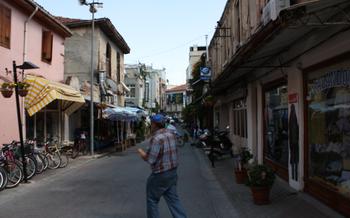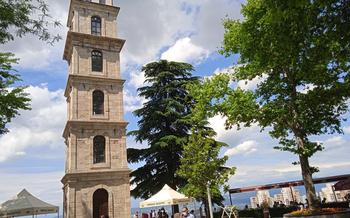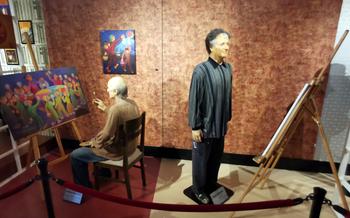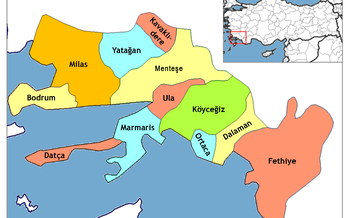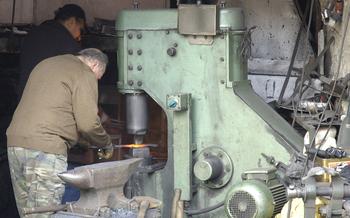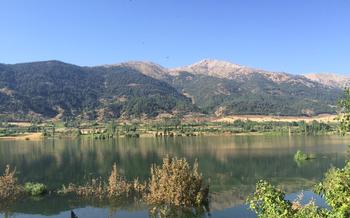
The Covered Bazaar (Bedesten)
- History of the Covered Bazaar (Bedesten)
- Location and Accessibility
- Opening Hours and Admission
- Shopping Experience
- Cultural Significance
- Architectural Highlights
- Local Delights
- Souvenirs and Handicrafts
- Photography Opportunities
- Historical Context
- Local Customs and Traditions
- Hidden Gems
- Tips for Navigating the Bazaar
- Photography Etiquette
- Insider Tip:
History of the Covered Bazaar (Bedesten)
Step into the labyrinthine alleys of Kahramanmaraş's Covered Bazaar, a historical gem that has stood as a testament to the city's rich trading heritage for centuries. Built in the 15th century during the reign of the Ottoman Sultan Mehmed II, this architectural marvel has witnessed the ebb and flow of civilizations and the evolution of commerce in this vibrant region.
The bazaar's unique structure, with its vaulted ceilings and intricate stonework, reflects the architectural prowess of its time. Its central courtyard, bathed in natural light filtering through strategically placed skylights, creates an ethereal atmosphere that invites shoppers to explore its hidden treasures.
Once a bustling hub for trade and commerce, the Covered Bazaar played a pivotal role in the city's economy. Merchants from across the region gathered here to exchange goods, fostering cultural exchange and fueling the growth of the local economy. Over the centuries, the bazaar has undergone renovations and adaptations, reflecting the changing needs and tastes of its time. Yet, despite these changes, it has retained its historical charm and continues to be a vibrant center of activity.
Keywords: Historical significance, architectural style, trade and commerce, evolution over time.
Location and Accessibility
The Covered Bazaar (Bedesten) is situated in the heart of Kahramanmaraş, one of Turkey's southeastern provinces. It is nestled amidst the labyrinthine streets of the old city center, a stone's throw away from the iconic Grand Mosque. The bazaar is easily accessible on foot, with well-marked signs guiding visitors from various directions.
For those arriving by car, there are designated parking areas within walking distance. Alternatively, public transportation is readily available, with several bus lines stopping nearby. To avoid the hustle and bustle of crowds, it's advisable to visit the bazaar during weekdays or early mornings.
The Covered Bazaar is surrounded by a treasure trove of historical landmarks, including the Kahramanmaraş Castle, the Dulkadiroğlu Mansion, and the Arasta Bazaar. Visitors can conveniently explore these attractions while immersing themselves in the vibrant atmosphere of the old city.
Opening Hours and Admission
The Covered Bazaar (Bedesten) in Kahramanmaraş follows specific opening hours and admission policies to ensure an organized and enjoyable shopping experience for visitors. The bazaar is typically open six days a week, from Monday to Saturday, allowing ample opportunities to explore its vibrant offerings. On Sundays, the bazaar remains closed, providing a day of rest for shopkeepers and vendors.
To enter the bazaar, there is no admission fee or charge required. Visitors are welcome to freely browse the stalls, admire the merchandise, and engage in the bustling atmosphere without any financial obligation. This free admission policy encourages both locals and tourists to immerse themselves in the bazaar's vibrant energy and discover its hidden treasures.
While the bazaar maintains consistent opening hours throughout the week, it's worth noting that during the holy month of Ramadan, the operating schedule may undergo slight adjustments. During this period of fasting and reflection, the bazaar might have reduced hours or altered operating days. It is advisable to check with local sources or the bazaar's management for specific information during Ramadan to avoid any inconvenience.
For those seeking the most optimal time to visit the bazaar, weekdays are generally recommended. During weekdays, the bazaar tends to be less crowded, allowing for a more leisurely and focused shopping experience. Vendors are often more attentive and can provide personalized assistance to customers during quieter periods.
On weekends, particularly on Saturdays, the bazaar experiences a surge in foot traffic as locals and tourists flock to take advantage of the lively atmosphere and bustling trade. While this can add to the energetic ambiance, it may also mean navigating through crowds and encountering higher prices due to increased demand.
Whether you prefer a serene and intimate shopping experience or the vibrant energy of a bustling crowd, the Covered Bazaar (Bedesten) in Kahramanmaraş offers a welcoming and enriching environment for all visitors. Plan your visit accordingly to make the most of its unique atmosphere and diverse offerings.
Shopping Experience
The Covered Bazaar (Bedesten) is a shopper's paradise, offering a vast array of goods and souvenirs. From traditional Turkish handicrafts to modern souvenirs, there's something for everyone. Be prepared to bargain, as it's a cultural norm and part of the shopping experience. Don't be afraid to haggle and negotiate prices with the vendors. You'll find everything from carpets and textiles to ceramics, jewelry, and antiques. Local crafts and specialties include intricate carpets, handmade pottery, and beautiful jewelry. When shopping, be respectful and mindful of the local culture and customs. Remember to dress modestly and avoid wearing revealing clothing.
Cultural Significance
The Covered Bazaar (Bedesten) in Kahramanmaraş is not merely a shopping destination but also a vibrant representation of Turkish culture and heritage. It has become an integral part of the city's identity, reflecting the rich traditions and customs that have shaped the region over centuries. The bazaar serves as a meeting point for locals and tourists alike, fostering a sense of community and cultural exchange.
One of the most striking aspects of the bazaar's cultural significance is its role in preserving and promoting local crafts. Artisans from all over the region gather here to showcase their handmade products, ranging from intricate carpets and ceramics to exquisite jewelry and textiles. Visitors can witness the artisans at work, gaining insights into the traditional techniques and skills that have been passed down through generations.
The bazaar also plays a crucial role in supporting the local economy. By purchasing directly from the artisans, visitors contribute to the livelihoods of these skilled individuals and their families. This support helps sustain traditional crafts and ensures that these unique skills continue to thrive in the modern era.
Moreover, the bazaar serves as a cultural bridge between the past and the present. The historical architecture, the vibrant atmosphere, and the bustling trade evoke a sense of nostalgia, reminding visitors of the rich history of the region. The bazaar is a living testament to the enduring spirit of Turkish culture and its ability to adapt and evolve over time.
Architectural Highlights
The Covered Bazaar (Bedesten) in Kahramanmaraş is a marvel of Ottoman architecture, showcasing unique features that reflect its rich history and cultural significance. The bazaar's striking facade, with its intricate stone carvings and pointed arches, immediately captures the attention of visitors. Inside, the bazaar is a maze of narrow, winding streets, lined with shops and stalls selling a variety of goods. The streets are covered by a series of domes and vaults, which create a cool and shaded environment even on hot summer days.
The architectural style of the bazaar is typical of Ottoman architecture, with its emphasis on symmetry, geometric patterns, and the use of domes and arches. The bazaar's domes are particularly impressive, with their intricate designs and vibrant colors. The bazaar has undergone several renovations and restorations over the years, but its original architectural features have been carefully preserved.
The Covered Bazaar (Bedesten) is a valuable example of Ottoman architecture and is considered one of the most important historical buildings in Kahramanmaraş. It is a testament to the skill and craftsmanship of the Ottoman builders and continues to serve as a vibrant center of trade and commerce in the city.
Local Delights
Indulge in the tantalizing flavors of traditional Turkish cuisine and street food at The Covered Bazaar. From gözleme, a savory flatbread filled with cheese, spinach, or minced meat, to börek, a flaky pastry stuffed with various fillings like potatoes, cheese, or meat, there's a culinary adventure waiting around every corner. Don't miss the chance to try Turkish delight, a sweet delight made with sugar, cornstarch, and flavors like rose, lemon, or pistachio.
For a taste of local delicacies, visit one of the many restaurants or cafes within or near the bazaar. Savor the aromatic kebabs, grilled meats served with fresh vegetables and rice, or tantalize your taste buds with Turkish coffee, a rich and flavorful brew that's a national obsession.
Embrace the vibrant food scene of The Covered Bazaar, where every bite is a journey into Turkish culinary heritage.
Souvenirs and Handicrafts
The Covered Bazaar is a treasure trove of souvenirs and handicrafts, making it the perfect place to pick up unique mementos of your trip to Kahramanmaraş. From intricately woven carpets and colorful ceramics to delicate jewelry and hand-painted miniatures, there's something for every taste and budget.
When shopping for souvenirs, be sure to haggle with the vendors. Bargaining is a way of life in Turkey, and you can often get a significant discount if you're willing to negotiate. Just be respectful and friendly, and don't be afraid to walk away if you're not happy with the price.
Some of the must-buy souvenirs at the Covered Bazaar include:
- Carpets: Kahramanmaraş is renowned for its high-quality carpets, which are hand-woven using traditional methods.
- Ceramics: The city is also known for its beautiful ceramics, which are often decorated with intricate patterns and vibrant colors.
- Jewelry: You'll find a wide variety of jewelry at the Covered Bazaar, from gold and silver pieces to semi-precious stones.
- Hand-painted miniatures: These small paintings are a unique and affordable way to take home a piece of Turkish art.
By shopping at the Covered Bazaar, you're not only getting a great souvenir, you're also supporting local artists and the local economy. So take your time, browse the stalls, and find the perfect treasures to take home with you.
Photography Opportunities
The Covered Bazaar is a visual feast, offering countless opportunities to capture stunning photographs. The vibrant colors of the textiles, the intricate designs of the carpets, and the gleaming gold jewelry create a kaleidoscope of visual wonders. The architecture itself is a masterpiece, with its soaring arched ceilings, ornate carvings, and colorful tiles.
To truly capture the essence of the bazaar, take your time and explore its hidden corners. Look for details that tell a story, such as a weathered door handle or a worn-out carpet. Don't be afraid to interact with the locals and ask them to pose for a photo. They are usually more than happy to share their stories and experiences.
For the best photos, visit the bazaar early in the morning or late in the afternoon, when the light is softer and more diffused. This will help you avoid harsh shadows and create more flattering images. If you're lucky, you might even catch a glimpse of the sun streaming through the stained-glass windows, casting a magical glow on the interior.
Whether you're a professional photographer or simply someone who loves to capture special moments, the Kahramanmaraş Bedesten is a treasure trove of photographic opportunities. So be sure to bring your camera and capture the beauty and vibrancy of this iconic bazaar.
Historical Context
The Covered Bazaar (Bedesten) in Kahramanmaraş is deeply intertwined with the rich history of Turkey. It played a pivotal role in trade routes and cultural exchange, serving as a hub for merchants and travelers from across the region. Throughout history, the bazaar has witnessed significant economic and social changes, leaving an indelible mark on the city's development.
The bazaar's roots can be traced back to the 15th century, during the reign of the Ottoman Empire. Kahramanmaraş was strategically located along trade routes connecting the empire's capital, Constantinople, to the Middle East and Central Asia. The city became a bustling center of commerce, and the Covered Bazaar emerged as a central marketplace for goods from far and wide.
Over the centuries, the bazaar has witnessed the ebb and flow of empires, cultural influences, and economic shifts. It survived fires, earthquakes, and political upheavals, standing as a testament to the resilience of the Turkish people. Today, the bazaar continues to thrive as a symbol of Turkey's rich historical heritage, attracting visitors from around the world who come to experience its unique atmosphere and vibrant traditions.
Local Customs and Traditions
When visiting the Covered Bazaar in Kahramanmaraş, it's essential to be respectful of local customs and traditions. This includes dressing appropriately, as the bazaar is a conservative environment. Women should cover their shoulders and knees, and men should avoid wearing shorts or tank tops. It's also important to be mindful of your behavior and avoid being too loud or disruptive.
When interacting with locals and vendors, it's customary to greet them with a handshake and a smile. Be prepared to bargain, as this is a common practice in the bazaar. However, be respectful and don't be afraid to walk away if you're not satisfied with the price.
It's also important to be aware of Turkish customs related to shopping. For example, it's considered polite to ask the vendor about the price of an item before touching or examining it. And if you're not interested in buying something, it's considered rude to haggle over the price.
By following these simple tips, you can ensure that you have a pleasant and respectful experience while visiting the Covered Bazaar in Kahramanmaraş.
Hidden Gems
Beyond the main aisles and popular stalls, the Covered Bazaar conceals a treasure trove of hidden gems waiting to be discovered. Explore the lesser-known corners of the bazaar to find unique shops and stalls specializing in rare antiques, handcrafted jewelry, and traditional textiles. Engage with local artisans who passionately create and sell their one-of-a-kind products, offering a glimpse into Turkey's rich artistic heritage.
Venture into the quieter alleys to uncover hidden courtyards where craftsmen work diligently on intricate carpets, pottery, and metalwork. Discover small cafes tucked away among the stalls, serving authentic Turkish coffee and delectable pastries. Embrace the opportunity to haggle with friendly vendors who genuinely appreciate the art of negotiation.
While exploring, keep an eye out for hidden architectural details that often go unnoticed by casual visitors. From intricate carvings on doorways to beautifully painted ceilings, the bazaar's hidden corners are a testament to its rich history and cultural significance.
Tips for Navigating the Bazaar
Navigating the bustling alleys of the Covered Bazaar can be both exhilarating and overwhelming. Here are some insider tips to make your shopping experience more enjoyable:
-
Plan Your Route: Before diving in, take a moment to orient yourself with a map or ask a local for directions. Plan a route that covers the specific areas or shops you're interested in, and stick to it to avoid getting lost.
-
Embrace the Crowds: While crowds are inevitable, they're also part of the bazaar's charm. Embrace the lively atmosphere and use the crowds to your advantage. Follow the flow of people to discover hidden gems and popular shops.
-
Avoid Peak Hours: If possible, try to visit the bazaar during off-peak hours, such as early in the morning or late in the evening. This will allow you to avoid the throngs of tourists and locals, making it easier to browse and shop at your own pace.
-
Handling Persistent Vendors: Vendors in the bazaar are known for their persistence, but it's essential to remain polite and firm. If you're not interested in a particular item, simply say "teşekkür ederim" (thank you) and move on.
-
Stay Alert and Aware: While the bazaar is generally safe, it's always wise to be cautious. Keep an eye on your belongings, avoid carrying large sums of cash, and be aware of your surroundings.
Photography Etiquette
Respectful Snapping
While capturing the vibrant atmosphere and architectural beauty of the bazaar through photography is encouraged, it's crucial to do so respectfully. Always ask permission before photographing people, especially women and children. Using flash photography can be disruptive and intrusive, so avoid it unless absolutely necessary. Be mindful of your surroundings and avoid blocking walkways or doorways while taking photos. Respect the privacy of others and refrain from taking photos that might make people feel uncomfortable or exposed. By following these guidelines, you can capture the essence of the bazaar without being intrusive or disrespectful.
Insider Tip:
For an unforgettable experience, visit the bazaar during the annual Kahramanmaraş Cherry Blossom Festival. The entire bazaar transforms into a vibrant sea of pink and white as cherry blossoms burst into bloom. The festival is a celebration of spring, local culture, and the region's famous cherries. Immerse yourself in the lively atmosphere, indulge in traditional Turkish cuisine, and capture breathtaking photos of the bazaar adorned with cherry blossoms. This festival provides a unique opportunity to witness the beauty of nature harmoniously blending with the historic charm of the Covered Bazaar.

